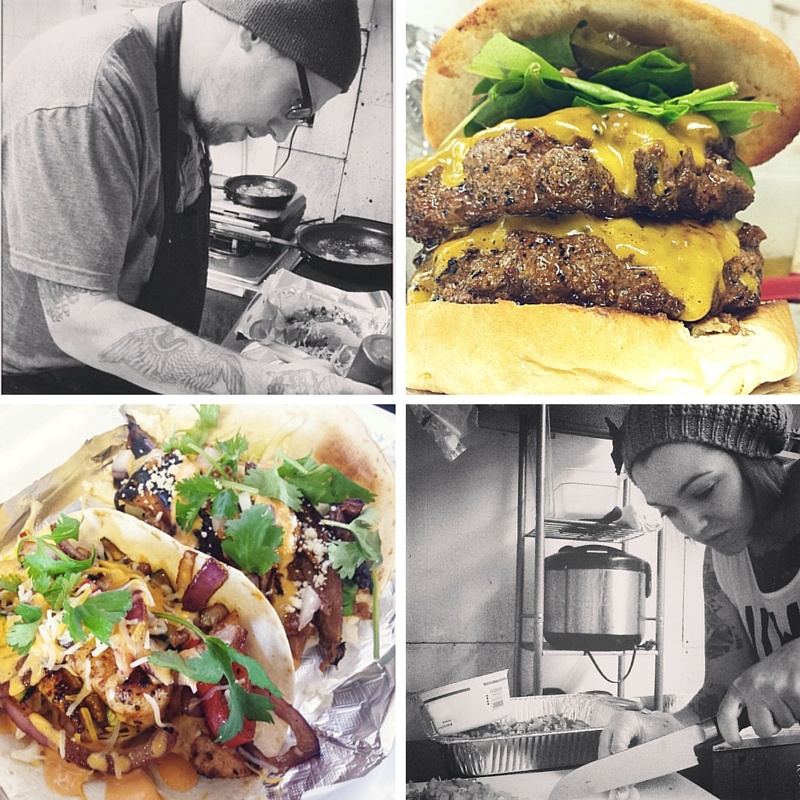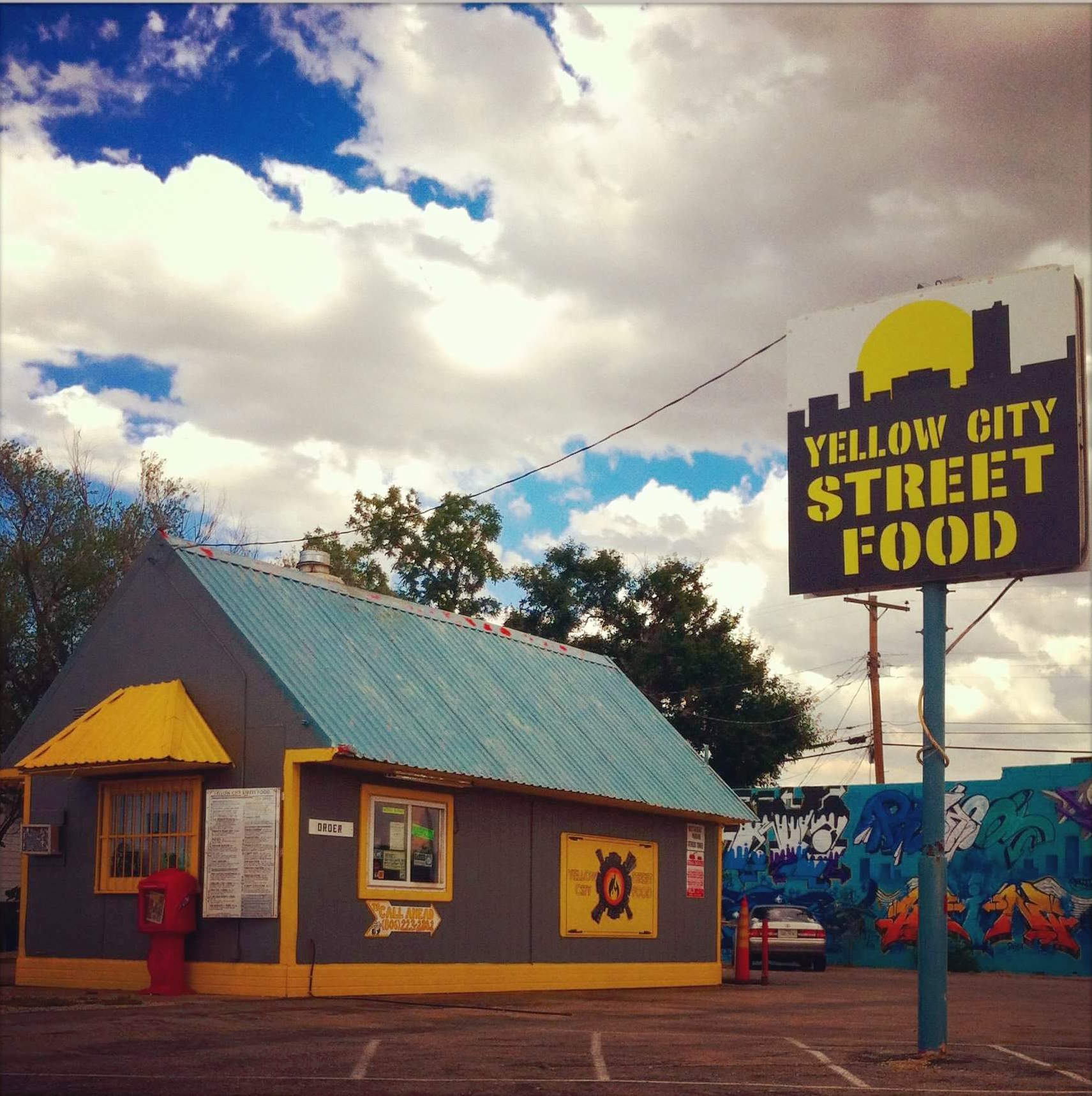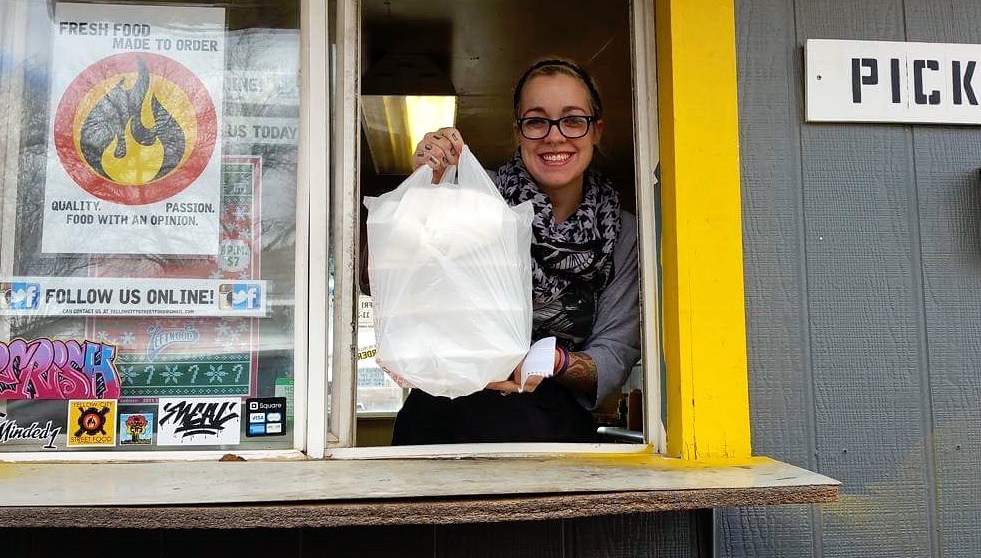“At the end of the day, we are just cooking food; we are doing what we love to do. We just want to interact with our customers for a little bit, feed them, and, hopefully, because of us, they will go on to have a great day.” — Scott Buchanan, Yellow City Street Food
Yellow City Street Food has become an Amarillo staple, not just for hungry residents, but also for passerby in the mood for hot, fresh, original fare. YCSF, which opened in 2013, offers patrons food-truck-like style menu. Essentially, gourmet eats on the go. To better meet their customer’s’ demands and , co-owners Scott and Rin Buchanan will leave behind its window-order eatery located on the corner of Southwest 10th Avenue and Madison Street and move to a dine-in restaurant with table service and craft beer, due to open this summer.
YCSF has also become a beacon of the caliber of food, service and style Amarillo is capable of providing. Recently, the AEDC sat down with culinary duo Scott and Rin to talk about how the community has embraced their restaurant and how YCSF strives to do the same.
A Conversation with YCSF
What’s your background?
Scott: Really, Yellow City Street Food started as a necessity for something different. I have been working in restaurants since ‘97. We were wanting to do our own thing. We wanted to start as a food truck. All over the country the food truck industry was exploding… People were using food trucks as the entry for a brick and mortar restaurant. While looking for a food truck, Rin found our current spot on Craigslist, and we jumped on it. Now people ask us if we are going to get a food truck still; but no, that would be a step backwards. We are trying to move forward.
 How did your experience lead you to Yellow City Street food?
How did your experience lead you to Yellow City Street food?
Scott: I started off as a line cook and a dishwasher and have worked up the ladder of restaurant jobs. I worked in Austin for six or seven years, and then came back here and bounced around. After you work for enough people, you develop your own identity as a chef, but you never get to see your own identity on the plate until you are fully in charge, as an owner. Initially, we just wanted to start something cool. We thought Yellow City Street Food would be a little late night spot that only our friends would come by. Then, when it blew up like it did — we have really just been riding the wave. I feel like everything we have done has been building up to this moment, but, at the same time, we are still flying by the seat of our pants.
What is your sense of local support?
Scott: I think support is paramount. I think it is imperative because if you have a problem, you have someone to bounce ideas off of or to ask for solutions. If something goes wrong, you have people that will rally behind you. Recently, we got broken into, right after the loss of our employee and best friend. The community rallied behind us. A fan of the restaurant started a Support Me page and raised a crazy amount of money for us without us ever asking. Especially in the service industry, you hope there are going to be people that will rally behind you.
You hope you will develop a huge following and I think we have done that here, in Amarillo. We have seen a huge response and we try to equally put that love out and support local. Any money we spend we try to put it back into the community. If we are going out to eat, we try the best we can to go eat somewhere locally — a restaurant that is locally owned or somewhere we know where the money is going.
Was there a learning curve opening your own restaurant?
Scott: Hindsight is 20/20. I think the big thing is to never be surprised, you will always be hit with something. It is almost like having a baby — everyday is exciting.
Rin: I remember when we first started, we looked at each other, Scott asked, “Do you want to do this?” and I knew I definitely wanted to do it. Then we jumped in, and I was like, “Oh my gosh.” I had no idea. I did not realize that you work from 7 a.m. to 9 or 10 p.m. Work is constant. Work for the restaurant is non-stop, all the time. I did not realize the hours you invest in a restaurant. One other thing I did not expect were all the review sites. You get so much feedback and it is overwhelming. When you get the negative feedback, when the reviews are really ugly — ouch! I did not like that. We care so much, that the great reviews make us feel so great; but the bad reviews hurt so much more.
What is the process behind the menu at Yellow City Street Food?
Rin: We used to have a large menu, so now we have scaled it down. We pick from the favorites off of the old menu, and then Scott throws in fun specials.
Scott: The menu, like Rin said, the first year we opened, had 22 items. We would change it every three months, seasonally. With everything on the menu, our food cost was all over the place. Things would sell; everything sold well. Generally, we would sell out of the whole menu, but different things would fluctuate. So to get a handle on food cost, we started changing the menu more frequently. And since we have lost our employee, it has slimmed down more and we change it daily.
I will come up with stuff. I will take a riff of something I have seen someone do and then do it my own way or if I see a sauce someone has made with certain ingredients, I will find something complementary. I try to work with the seasons; I also work with ingredients that we see a lot of in the area. We make a lot of our own stuff too. We make our vinegars and a lot of our sauces. Most of our stuff is crafted… That is why the our new restaurant will be called YCSF Craft. Not only because of the craft beer, but also because we are as hands-on as possible. And the menu is a reflection of that.
Mainly, I always try to push the envelope. I do not ever want someone to eat something of mine and say, “Oh, it’s good, but I’ve had it somewhere else.”
 Would you say you have a strong farm-to-table atmosphere?
Would you say you have a strong farm-to-table atmosphere?
Scott: We definitely want to push more of a farm-to-table atmosphere with our restaurant. There is a produce collective out of Lubbock that I have been talking to, trying to get more stuff that is grown here. We have established a relationship with the Parrera pastures. They have amazing raw milk and they come town to sell chocolate milk, strawberry milk, but they also have ricotta and feta.
We support farm-to-table 100%. The thing that makes our restaurant different is not only the recipes, but also how we source ingredients. We want to start with more fresh ingredients, then create sauces and everything from scratch. If you shop United or Walmart, it is the usual suspects there in the produce section. You cannot create your own identity culinarily until you start getting ingredients that everybody does not have or getting a variety of ingredients.
We are thinking about trying to coalesce something, to get fans of the restaurant to grow stuff in their garden and bring it to the restaurant. That is great for produce, but if we went to source meat, there’s the USDA to go through, and you cannot really get that going here.
At Yellow City Street Food, what would you consider the highest form of flattery?
Scott: If you go to pick up the trash and you see a bunch of empty boxes, you know that is a good. Clean plates are always a good sign. At the end of the day, we are just cooking food; we are doing what we love to do. We just want to interact with our customers for a little bit, feed them, and, hopefully, because of us, they will go on to have a great day. As long as people are happy and talking about our food.
Rin: We have some customers that are there daily, right when we open, and it is the sweetest thing. We have had one guy since the beginning who has been the biggest warrior for us on social media. He always posts pictures of his food, saying, “Oh my gosh, I got this from Yellow City today.” Now, we give him a discount every time he is at YCSF.
The day those food trucks came through Amarillo, that was probably the biggest day we have ever had. People were saying, “I am not supporting these food trucks. Why is there this big excitement over these trucks when we have our own street food here?” Our line was crazy that day. It was a huge compliment — people were willing to wait hours. The line was so long that by the time we got to the very last car, the woman said, “I have been in line for two hours, but it has been worth every minute.”
With YCSF, what has been your greatest challenge?
Rin: Trying to accommodate the demand. We have outgrown our space, and the building we are in is falling apart. We are busting out of the seams.
Scott: Also, helping people understand that we are not fast food. Trying to help people understand that we do not just arrive at eleven o’clock, open the doors, the food is ready to go, we just have to turn the oven on and start cooking. People do not realize that I am up all night cooking pork; then we are up at seven getting the kids ready. I wish people could have a little glimpse into everything that goes on because people do not think about the process behind their meal. Our food is good, it is comforting, it is street food, but there are a lot of technical aspects. Our food takes a lot of prep work, and there are just two of us.
Helping to educate people has been a little bit of challenge. It has been awesome to educate people, but, at first, it was a hurdle trying to introduce new flavors or ingredients. Even in the beginning, some of our regulars were pretty apprehensive about having quinoa or even aioli on the menu. Now if they show up and we are sold out of something or even half of the menu is sold out, we hear “I don’t care. Just give me something. I’ll taste anything.” It has been awesome to see people go on a journey with us.
How will having your new space on Wolflin change your business?
Rin: Scott loves to plate. He plates very artistically, so that excites Scott. Giving the food out on a plate will definitely be nicer than food from a styrofoam box.
Scott: Coming from a fine dining background, the plate is the stage for the food.
Rin: Also, people will be able to sit down and enjoy their food. Everybody will not be showing up at the same time to wait in a line. With our line, we have had to condense our interactions with our people and our interactions with our food down to a wait time. Now, people can come into a normal restaurant setting without that huge wait time. Interactions will not just be limited to: “‘What do you want?” or “Can I take your order? “OK, bye.” With our current set-up, it has been minimal, quick interactions so I can get back to helping Scott cook.
Now, we can create a whole experience outside of the car. Although, some customers will miss that. People have told us, “Oh, I like going through the drive-through for this kind of food.” We are hoping to cater to both people. This is just one of those things: We are doing it, we are going to see what happens, and we will fix it as we go.
 Scott: We have done as much as we can out of the drive-through. Now, we are ready to provide the same comforting street food experience, but we will be able to grow up a little bit in our new space, do things we have not been able to do before. Many of the dishes we have done, we will now be able to do them on a larger scale, and we will be able to pair dishes with beer or wine. Having the beer and beverage program will really elevate our food to the next level. Being able to have people stage out their order like a normal restaurant- appetizers, mains, drinks, desserts- is exciting.
Scott: We have done as much as we can out of the drive-through. Now, we are ready to provide the same comforting street food experience, but we will be able to grow up a little bit in our new space, do things we have not been able to do before. Many of the dishes we have done, we will now be able to do them on a larger scale, and we will be able to pair dishes with beer or wine. Having the beer and beverage program will really elevate our food to the next level. Being able to have people stage out their order like a normal restaurant- appetizers, mains, drinks, desserts- is exciting.
Ultimately, we are cooking food. It is a basic and primitive idea, but we are trying to put our spin on it; we are trying to make food exciting. With Yellow City, it is like you are getting a fine dining experience, but we have cut out the restaurant; we have cut out the middle man. Now, since we have grown so big, we need to have that brick and mortar restaurant, but YCSF Craft will offer a similar experience. We are sourcing out carefully, so we can still provide an amplified experience at a reasonable price.
Tell us about the food culture in Amarillo.
Scott: I think there is more of a foodie culture starting here. Honestly, before now, I feel like the standard has stayed low with the food expectation, but people are starting to push the envelope now, which is really exciting.
There is a complacency here. People will say, “Oh, we got a Texas Roadhouse,” or people will get excited about Saltgrass or something similar. People have been excited about chains, but nobody is excited about local. Unfortunately, it is not just the people that are eating the food, but nobody has been inspired or excited enough to do something about the food scene here. We have friends that work in the food industry here and friends that run restaurants here. Without speaking ill of them, they come into work, clock in, at work they are focused, they do their job well, but when they leave work, they shut off, they do not want anything more. Everybody seems cool with that. Not us; we want to push Amarillo. It is depressing when you go on a trip, you have eaten at all of these cool places out of town, you come back and it’s like “Ahh.”Then, everybody comes to our place, but where do we get to eat when we get off work?
As much as we are trying to push what we do to be the best restaurant we can, to be the best restaurant in Amarillo, I also hope that competition might create a bit of a higher air. We do not think we are directly competing with anybody in town, but we also want people to see what we are doing and to step up their game too. We are trying to raise the standard, to push Amarillo to push the envelope. We are small, but we hope there is a ripple of change behind the work we have done.
Nobody wants to jump first, but that is what we did. We are jumping, we are putting ourselves out there, we are trying to create a movement, trying to create change. We have actually seen that drive in people lately. Chefs we know in town have this excitement about what they are doing and I love seeing people get excited for that change and progression.
Rin: I do think we have inspired people because they look at this little bitty shack [and] they see what we have done with just 200 square feet.
What does Amarillo’s community mean to you?
Rin: Six hours after our best friend passed, away my father passed away, and then two weeks later we had a robbery. The community was really strong; they were there for us. The community rallied behind us — and that spoke volumes. It was amazing. It really restored my faith in the City. We knew we had customers, but to hear them say, “I am here for you all around,” it was amazing.
Scott: I feel like as local business, being integrated into this community… this community is everything to us, so we do everything we can for them. It is our life’s blood obviously, but what we are doing requires a dynamic relationship. We definitely lean on each other. It’s a very tight-knit community and seeing the regulars we have every day really instills that belief.
Photos courtesy of Yellow City Street Food
{{cta(’25cc3908-e48e-4a67-a16f-c1fdcf5e245c’)}}








